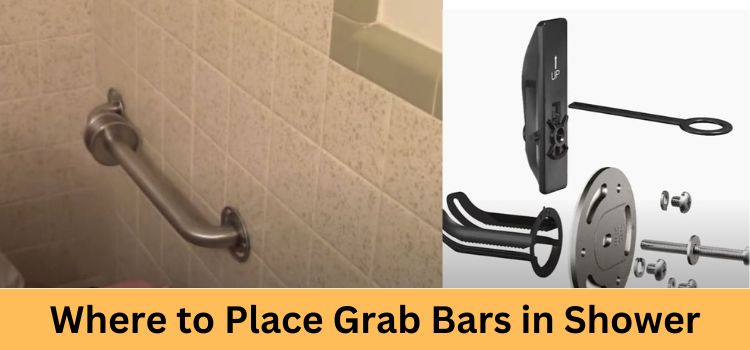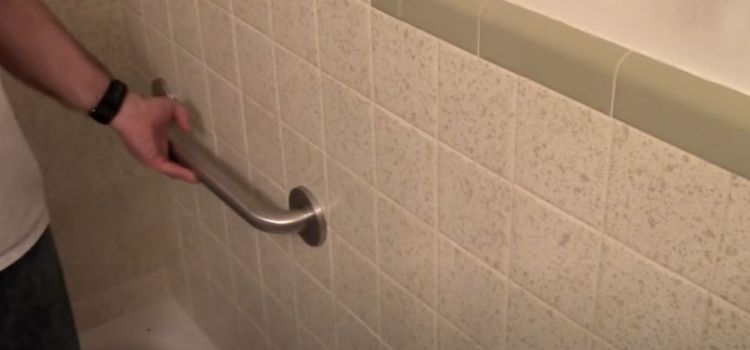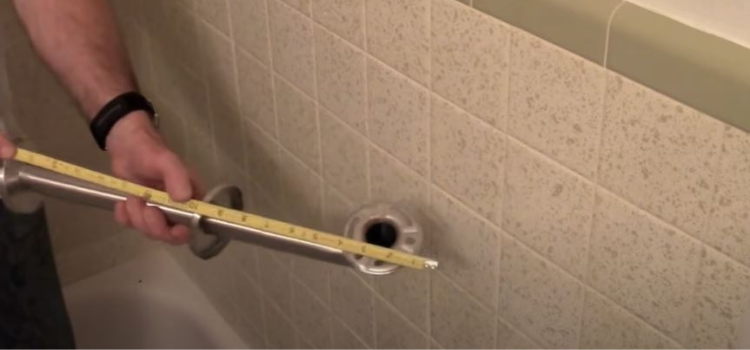
Introduction
Safety should always come first in a restroom. This is especially true in the shower, where slippery surfaces can increase the risk of slips and falls. Installing grab bars in the shower is a simple yet effective way to enhance safety and provide additional support for individuals, particularly those with limited mobility or balance issues.
Grab bars offer stability and assist with maintaining balance, reducing the risk of accidents and injuries. They can be a valuable addition to any shower, providing peace of mind and ensuring a safer bathing experience.
In this comprehensive guide, we will explore the essential tips for placing grab bars in the shower. From understanding the importance of grab bars for bathroom safety to the optimal placement and types of grab bars, we will cover everything you need to know to make informed decisions about grab bar installation in your shower. So, let’s dive in and discover the key considerations for creating a safer and more accessible shower environment.
Understanding the Importance of Grab Bars for Shower Safety
Bathroom safety is a vital concern for individuals of all ages and abilities. Slippery surfaces in the shower pose a significant risk of slips and falls, which can lead to severe injuries. This is especially true for individuals with limited mobility, balance issues, or disabilities.
Grab bars play a crucial role in preventing bathroom falls by providing support and stability. They act as a secure handhold, allowing individuals to maintain their balance while entering, exiting, and manoeuvring within the shower. By offering a reliable grip, grab bars reduce the risk of slips and falls, providing individuals with the confidence and peace of mind to navigate the shower safely.
The importance of grab bars for bathroom safety is recognized by various organizations, including the Americans with Disabilities Act (ADA). The ADA sets guidelines for accessible design and recommends the installation of grab bars in public facilities to ensure the safety and accessibility of individuals with disabilities. While these guidelines are not mandatory for residential settings, they serve as a valuable reference for optimal safety and accessibility.
The Role of Grab Bars in Preventing Bathroom Falls
Grab bars play a crucial role in preventing bathroom falls by providing stability and support. In the shower, where surfaces can become slippery, the risk of slips and falls is heightened. By strategically placing grab bars near the shower entrance, on the side wall, and near the bathtub, individuals can have something to hold onto for balance and support.
When entering or exiting the shower, having a grab bar nearby reduces the risk of losing balance and falling. Grab bars provide a secure handhold and a stable support point, giving individuals the confidence to navigate wet and slippery surfaces safely. By offering this additional stability, grab bars play a crucial role in preventing bathroom falls, especially when pulling oneself up from a sitting position in the shower.
How Grab Bars Provide Support and Stability
Grab bars provide additional support and stability in the shower, making it easier for individuals to maintain their balance while standing or moving. They serve as a reliable handhold, offering a sense of security and confidence.
For individuals who may need assistance or support while bathing, grab bars are particularly beneficial. They can be strategically placed near a shower seat or chair, providing stability and a secure grip for individuals transitioning between sitting and standing positions. This additional support from grab bars ensures a safer and more comfortable bathing experience for individuals with mobility issues or disabilities.
Essential Considerations Before Installing Grab Bars

Before installing grab bars in your shower, there are a few essential considerations to keep in mind. These considerations will help ensure that the grab bars are placed correctly and securely anchored and provide optimal support and safety.
One crucial consideration is the placement of the grab bars. Determining the ideal locations for the grab bars will depend on factors such as the needs of the individuals using the shower, the layout of the shower, and the availability of suitable mounting locations. Additionally, it’s essential to consider the structure of the shower wall and the presence of wall studs to ensure proper anchoring.
Assessing the Needs of Users
Before installing grab bars in the shower, it’s crucial to assess the needs of the individuals who will be using the bathroom. This assessment will help determine the type, placement, and number of grab bars required.
Individuals with mobility issues, disabilities, or balance concerns may require grab bars that offer additional support and stability. The Americans with Disabilities Act (ADA) provides guidelines for accessible design, including recommendations for grab bar placement in public facilities. While these guidelines are not mandatory for residential settings, they offer valuable insights into creating a safer and more accessible bathroom environment.
Evaluating the Shower Space and Structure
Another important consideration before installing grab bars in the shower is evaluating the shower space and its structure. Understanding the dimensions and layout of the shower will help determine the most suitable grab bar placement and orientation.
It’s essential to consider the presence of wall studs, as these provide a secure anchoring point for the grab bars. Wall studs are vertical wooden beams within the wall structure that offer strength and stability. By anchoring the grab bars directly into the wall studs, you ensure their effectiveness and safety.
Optimal Placement of Grab Bars in Showers

Proper placement of grab bars in the shower is essential for ensuring optimal support and safety. By strategically positioning grab bars; individuals can have something to hold onto for stability and balance while using the shower.
One of the most critical areas where grab bars can be installed in a walk-in shower is near the shower entrance. This vertical grab bar provides support and stability when entering or exiting the shower. It helps individuals maintain their balance and reduces the risk of slips and falls. To determine the placement of the vertical grab bar, consider positioning it near the shower door jamb.
This vertical grab bar, also known as a vertical grab bar, provides a secure handhold as users step over the small lip or ledge between the bathroom floor and the shower floor. Placing the grab bar vertically about 4-6 inches inward from the entrance or shower door jamb ensures it is easily accessible and provides a sturdy grip for users.
Near the Shower Entrance for Safe Entry and Exit
Placing a grab bar near the shower entrance is essential for safe entry and exit. This vertical grab bar provides support and stability when individuals step over the small lip or ledge between the bathroom floor and the shower floor. By positioning the grab bar near the shower door jamb, users have a secure handhold to maintain their balance and reduce the risk of slips and falls.
When determining the placement of the vertical grab bar, consider positioning it about 4-6 inches inward from the entrance or shower door jamb. This ensures the grab bar is easily accessible and provides a sturdy grip for users. The height placement of the vertical grab bar should be based on the user’s comfort and reach.
Consider the individual’s height and where their hand reaches comfortably when entering or exiting the shower. Additionally, if there is a shower seat or chair, ensure that the hand can comfortably reach the bottom of the vertical grab bar for added support.
Inside the Shower at Various Heights for Standing and Seating Positions
Inside the shower, grab bars should be strategically placed at various heights to accommodate different standing and seating positions. These grab bars offer support and stability for individuals while they navigate the shower space.
For individuals who primarily stand while showering, horizontal grab bars should be positioned on the side wall of the shower. Placing the grab bars at a height of approximately 33-36 inches above the shower floor ensures they are easily reachable and provide adequate support for users of different heights. These horizontal grab bars offer a steady handhold and assist with maintaining balance while standing and moving within the shower.
For individuals who use a shower seat or chair, vertical grab bars should be installed on the side wall, approximately 18 inches from the back wall. These vertical grab bars provide support and stability for individuals transitioning between sitting and standing positions. By having a secure handhold, individuals can manoeuvre in and out of the shower seat with confidence and reduce the risk of falls.
Types of Grab Bars and Their Benefits
When it comes to grab bars, there are different types available, each with its benefits. The choice of grab bars depends on factors such as personal preference, bathroom design, and the specific needs of the users.
Stainless steel grab bars are a popular choice due to their durability, corrosion resistance, and ease of maintenance. They are strong, reliable, and can withstand daily use without losing their functionality. Stainless steel grab bars also come in various finishes, allowing them to blend seamlessly with different bathroom styles.
Weight capacity is another important consideration when choosing grab bars. Most grab bars are designed to support a minimum weight of 250 pounds, but options with higher weight capacities are available for added safety and stability. It’s important to select a grab bar that comfortably accommodates the needs of the users.
Straight vs. Angled Grab Bars
When choosing between straight and angled grab bars, it’s important to consider the specific needs and preferences of the users. Both types of grab bars offer support and stability, but they provide different ergonomic benefits.
Straight grab bars offer a straightforward handhold for individuals to grasp and maintain their balance. They are versatile and can be installed in various locations within the shower to suit the specific requirements of the users. Straight grab bars provide optimal support for individuals who prefer a traditional grip and do not require additional ergonomic features.
Angled grab bars, on the other hand, provide an ergonomic grip angle that reduces stress on the wrists. This can be particularly beneficial for individuals with limited hand strength or dexterity. The angle of the grab bar allows for a more comfortable and secure grip, enhancing stability and support.
Temporary vs. Permanent Installation Options
When it comes to installing grab bars in the shower, both permanent and temporary installation options are available. The choice between the two depends on factors such as personal preference, bathroom design, and the need for flexibility.
Permanent installation involves securely anchoring the grab bars to the shower’s structure, typically using wall studs for maximum strength and stability. This type of installation provides a long-lasting solution and is ideal for individuals who require permanent support and stability in the shower.
Temporary installation, on the other hand, involves using suction cups or other non-permanent methods to attach the grab bars to the shower walls. While this option offers flexibility and easy installation without the need for drilling or permanent fixtures, it may provide a different level of support and stability than a permanently installed grab bar. Temporary grab bars typically have lower weight capacities and may not be suitable for individuals who require substantial support.
The Technical Side of Installing Grab Bars

Proper installation is crucial to ensure the effectiveness and safety of grab bars in the shower. By following the correct installation process and using the right tools and materials, you can provide a secure and reliable grab bar installation.
Before starting the installation process, it’s essential to gather the necessary tools and materials. Here’s a list of the tools and materials commonly used for grab bar installation:
- Grab bars: Choose grab bars that meet your specific needs in terms of size, weight capacity, and material.
- Wall anchors: Wall anchors provide additional support and stability by securely mounting the grab bars to the wall. Choose the appropriate anchors based on your shower’s wall construction.
- Stud finder: A stud finder is used to locate the wall studs, which provide the most vital anchoring points for grab bars.
- Screws: Choose screws that are appropriate for your grab bar and wall construction. Stainless steel screws are often recommended for their durability and resistance to corrosion.
Once you have the necessary tools and materials, you can follow these step-by-step instructions for grab bar installation:
- Use a stud finder to locate the wall studs in the shower. Wall studs provide the most vital anchoring points for grab bars.
- Mark the desired location for the grab bars, ensuring they are positioned at the appropriate height for the users.
- If the grab bar is installed into a wall stud, pre-drill pilot holes will be placed into the marked locations.
- If the grab bar is installed between wall studs, wall anchors will be used to provide additional support and stability. Follow the manufacturer’s instructions for installing the wall anchors.
- Attach the grab bar to the wall using screws, making sure they are securely fastened.
- Test the grab bar to ensure it is stable and can support the weight of the users.
Identifying the Right Tools and Materials
Identifying the right tools and materials is an essential step in grab bar installation. Having the appropriate tools and materials ensures a smooth and secure installation process.
When installing grab bars, you will need the following tools and materials:
- Grab bars: Choose grab bars that meet your specific needs in terms of size, weight capacity, and material. Stainless steel grab bars are a popular choice due to their durability and resistance to corrosion.
- Wall anchors: Wall anchors provide additional support and stability by securely mounting the grab bars to the wall. Choose the appropriate anchors based on your shower’s wall construction.
- Stud finder: A stud finder is a helpful tool for locating the wall studs, which provide the most vital anchoring points for grab bars. Use the stud finder to identify the stud locations before installation.
- Screws: Choose screws that are appropriate for your grab bar and wall construction. Stainless steel screws are often recommended for their durability and resistance to rust.
Step-by-Step Installation Process
Installing grab bars in the shower requires a step-by-step process to ensure proper anchoring and stability. Follow these instructions for a successful grab bar installation:
- Determine the desired location for the grab bars based on the specific needs of the users.
- Use a stud finder to locate the wall studs. Wall studs provide the most vital anchoring points for grab bars.
- Mark the locations for the grab bars on the shower wall, ensuring they are positioned at the appropriate height and distance for the users.
- If the grab bar is installed into a wall stud, pre-drill pilot holes will be placed into the marked locations.
- If the grab bar is installed between wall studs, wall anchors will be used to provide additional support and stability. Follow the manufacturer’s instructions for installing the wall anchors.
- Attach the grab bar to the wall using screws, ensuring they are securely fastened.
- Test the grab bar to ensure it is stable and can support the weight of the users.
Compliance and Standards for Grab Bar Installation
When installing grab bars in the shower, it’s important to consider compliance and standards to ensure optimal safety and accessibility. While compliance with specific guidelines may not be mandatory for residential settings, adhering to them can provide valuable insights and enhance the overall safety of the bathroom.
The Americans with Disabilities Act (ADA) provides specific guidelines for grab bar placement in public facilities to ensure accessibility. Following ADA standards can offer a valuable reference for residential grab bar installations.
In addition to ADA guidelines, it’s essential to comply with local building codes and regulations. Local codes may have specific requirements for grab bar placement, anchoring methods, and weight capacities.
Understanding ADA Guidelines for Grab Bars
The Americans with Disabilities Act (ADA) provides specific guidelines for grab bar placement in public facilities to ensure accessibility for individuals with disabilities. While these guidelines are not mandatory for residential settings, understanding them can help inform the installation of grab bars in your shower.
ADA guidelines recommend the following for grab bars:
- The grab bars should be mounted between 33 and 36 inches above the finished floor.
- The space between the wall and the grab bar should be 1.5 inches.
- The grab bars should have a diameter between 1.25 and 1.5 inches for easy grip and support.
Local Building Codes and Regulations
In addition to ADA guidelines, it’s essential to consider local building codes and regulations when installing grab bars in the shower. Local codes may have specific requirements for grab bar placement, anchoring methods, and weight capacities.
To ensure compliance with local building codes, it’s essential to research and understand the specific requirements applicable to your area. These requirements may vary depending on your location.
By following local building codes and regulations, you can ensure that your grab bar installation meets the necessary safety standards. Compliance with these codes not only provides a safer shower environment but also helps protect the structural integrity of your bathroom.
Maintenance and Upkeep of Shower Grab Bars
Once grab bars are installed in the shower, it’s essential to perform regular maintenance and upkeep to ensure their effectiveness and safety. By following some simple maintenance practices; you can prolong the lifespan of your grab bars and keep them in optimal condition.
Regularly inspect your grab bars for any signs of wear, damage, or loose fittings. Tighten any loose screws or fittings immediately. Ensure that the grab bars are securely anchored and provide stable support.
Cleaning your grab bars regularly is also essential to maintain their appearance and hygiene. Use mild soap and water to clean the grab bars, and avoid using harsh chemicals or abrasive cleaners that may damage the finish.
Regular Inspection for Safety
Regularly inspecting your grab bars is essential for ensuring their safety and effectiveness. By performing regular inspections, you can identify any signs of wear or damage and address them promptly.
During the inspection, check for any loose fittings, screws, or anchors. Ensure that the grab bars are securely anchored and provide stable support. If you notice any loose or damaged components, tighten or replace them as necessary.
Inspect the grab bars for any signs of rust, corrosion, or other damage to the finish. If you notice any discolouration or deterioration, consider replacing the grab bars to maintain their appearance and functionality.
Regular inspection is a crucial part of maintaining the safety and effectiveness of grab bars in the shower. By addressing any issues promptly, you can ensure that your grab bars continue to provide the necessary support and peace of mind.
Cleaning and Care Tips
Cleaning and proper care are essential for maintaining the appearance and functionality of your grab bars. By following some simple cleaning tips, you can keep your grab bars in excellent condition.
Regularly clean your grab bars using mild soap and water. Avoid using harsh chemicals or abrasive cleaners that may damage the finish of the grab bars.
Use a soft cloth or sponge to clean the grab bars, and rinse them thoroughly to remove any soap residue.
Dry the grab bars entirely after cleaning to prevent water spots or mineral deposits from forming.
Inspect the grab bars for any signs of rust, corrosion, or other damage. If necessary, use a rust remover or stainless steel cleaner to restore the finish.
Conclusion
In conclusion, understanding the optimal placement and importance of grab bars in your shower can significantly enhance safety and accessibility. By assessing user needs, evaluating space, and following installation guidelines, you can create a secure environment that minimizes the risk of falls. Regular maintenance and compliance with standards ensure continued effectiveness. Prioritizing these considerations not only promotes independence but also provides peace of mind for you and your loved ones. So, please take the necessary steps to install grab bars correctly and maintain them well to enjoy a safe and comfortable shower experience.
Frequently Asked Questions
What is the recommended number of grab bars in a shower?
The recommended number of grab bars in a shower depends on the size and layout of the shower space. Generally, it is advised to have at least two grab bars, with one on the back wall and another on a side wall, for proper support. However, the specific needs and preferences of the users should be considered for optimal safety and accessibility.
Can grab bars be installed on any surface?
Grab bars can typically be installed on most surfaces like tile, fibreglass, and acrylic walls. It’s crucial to ensure the surface is sturdy and can support the weight. Consult a professional if you need clarification on the suitability of the surface for grab bar installation.
How do I choose the right grab bar for my bathroom?
To choose the right grab bar for your bathroom, consider factors like user needs, shower space evaluation, and types of bars (straight vs. angled). Temporary or permanent installation options should align with safety standards and local regulations. Regular maintenance ensures long-term functionality.
